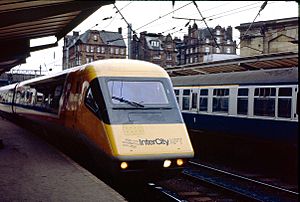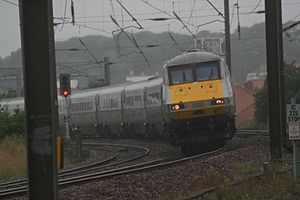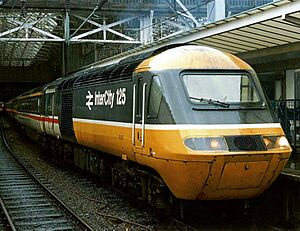Advanced Passenger Train facts for kids
The Advanced Passenger Train (APT) was a special, experimental train built by British Rail in the 1970s and early 1980s. It was designed to go very fast and could tilt around corners, like a motorbike. Even though it was very advanced, it never ran as a regular passenger train.
Contents
What Was the Advanced Passenger Train?
The APT was a project by British Rail to create a new type of fast train. It was meant to travel quickly on existing railway lines. This was different from building completely new, straight tracks for high-speed trains. The APT used clever technology to lean into curves. This allowed it to go faster without making passengers feel uncomfortable.
Why Did British Rail Develop the APT?
In the 1970s, British Rail wanted to improve train travel. They aimed to make journeys faster and more comfortable. The idea was to compete with cars and airplanes. The APT was their big plan to achieve this. It promised to cut journey times on busy routes.
How Did the APT Tilt?
The APT had a special system that allowed its carriages to lean. When the train went around a bend, hydraulic rams would push the carriage bodies. This made them tilt inwards, like a cyclist leaning into a turn. This tilting action helped to balance the forces on the train. It meant passengers didn't feel pushed to the side. This allowed the train to take curves at much higher speeds than regular trains.
What Made the APT Unique?
- Tilting Technology: This was the main new feature. It allowed the train to go faster on curved tracks.
- Lightweight Design: The train was built using lighter materials. This helped it accelerate faster and use less energy.
- Hydrokinetic Brakes: The APT used special brakes that worked with water. These brakes could stop the train very quickly from high speeds.
- Articulated Carriages: The carriages were joined together in a special way. This meant they shared wheels between them. This design made the train smoother and quieter.
Different Versions of the APT
There were a few different versions of the APT built:
The Experimental APT-E
The first version was called the APT-E (Experimental). It was built in 1972. This train was used to test the new tilting technology. It had gas turbine engines and was very noisy. It set a new British speed record of 152.2 miles per hour (245 km/h) in 1975. The APT-E helped engineers learn a lot about how the tilting system worked.
The Prototype APT-P
After the APT-E, British Rail built three prototype trains called APT-P (Prototype). These were closer to what a real passenger train would look like. They used electric power from overhead lines. The APT-P trains were tested on the West Coast Main Line. This line connects London to Glasgow.
Why Didn't the APT Go into Regular Service?
Even with all its advanced features, the APT faced many problems. These issues stopped it from becoming a regular train.
Technical Challenges
The tilting system was very complex. It sometimes had problems, especially in cold weather. The brakes also caused issues. They were very powerful but sometimes froze up. These technical difficulties made the train unreliable.
Public and Media Reaction
When the APT-P trains were briefly used for passenger trials in 1981, they had some breakdowns. This led to negative news reports. The public and media lost confidence in the train. This made it harder for British Rail to continue the project.
Funding and Political Issues
Developing the APT was very expensive. There were also changes in government and railway management. This meant less support and money for the project. In the end, British Rail decided to stop the APT project in 1986.
What Happened After the APT?
Even though the APT itself didn't succeed, its ideas were very important.
Legacy of the APT
The tilting technology developed for the APT was later used in other trains. For example, the British Rail Class 91 locomotives, which run on the East Coast Main Line, used some APT ideas. The tilting technology also influenced trains in other countries. The Pendolino trains, which run in the UK and Europe, use similar tilting systems.
The Success of the InterCity 125
While the APT was being developed, British Rail also created another high-speed train, the InterCity 125. This train did not tilt. Instead, it was designed to run fast on straighter sections of track. The InterCity 125 was very reliable and successful. It became a popular train for many years. Its success showed that simpler, proven technology could also work well for high-speed travel.
The APT was a bold experiment. It pushed the boundaries of train technology. Even though it didn't run regularly, its innovations helped shape future high-speed trains.
Images for kids
-
Driving controls of the Advanced Passenger Train (APT-P) at Crewe Heritage Centre.
-
Superelevation was applied to portions of the BR network, although the angle was limited. Here, a Class 91, based on APT technology, rounds a canted turn on the East Coast Main Line.
See also
 In Spanish: Advanced Passenger Train para niños
In Spanish: Advanced Passenger Train para niños










